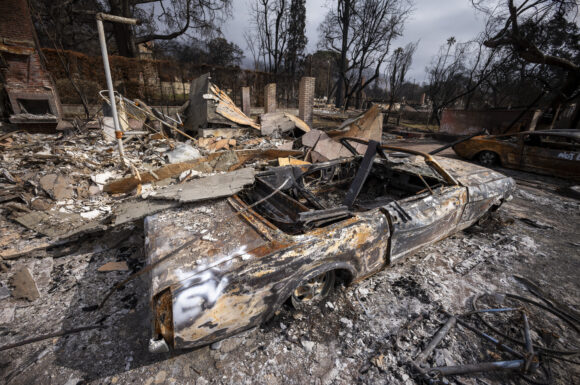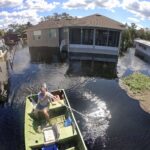Natural disasters across the globe cost insurers US$80 billion during the first half of 2025, up from $64 billion in H1 2024, according to Munich Re’s mid-year natural disaster report.
On the other hand, overall economic losses (which include insured claims) dropped slightly to $131 billion during H1 2025, compared with $155 billion last year (adjusted for inflation). Nevertheless, economic losses were well above the long-term average, Munich Re said.
The U.S., once again, drove natural disaster losses — particularly due to record-breaking wildfires around Los Angeles in January, said the report titled “Wildfires around Los Angeles, severe thunderstorms: US natural catastrophes dominate global losses in the first half of 2025.”
Read more: First-Half 2025 Insured Losses From Natural Cats Hit $100B, Driven by US Events
Both overall losses and insured losses were significantly higher than the average for both the previous 10 years and the previous 30 years. (Adjusted for inflation, average overall losses for the previous 10 years were $101 billion, while average losses for the previous 30 years were $79 billion. Average insured losses were $41 billion and $26 billion for the previous 10 years and 30 years, respectively.)
Munich Re said insured losses in H1 2025 were the second highest in the first half of any year since it began keeping records in 1980 — only surpassed by the first half of 2011 when insured losses were even higher, driven by a severe earthquake and destructive tsunami in Japan. (Editor’s note: In March 2011, a tsunami hit the Fukushima Daiichi Nuclear Power Plant — causing damage that resulted in the release of radioactive contaminants. Clean up and decommissioning of the plant will take decades.)
“Weather disasters caused 88% of overall losses and 98% of insured losses, while earthquakes accounted for 12% and 2%, respectively,” the Munich Re report said.
Los Angeles Wildfires
The wildfires in the greater Los Angeles area resulted in the costliest natural disaster during the first six months of 2025 with an overall loss of an estimated $53 billion, around $40 billion of which was insured, Munich Re said. The fires claimed the lives of 29 people.
“Never before had wildfires caused such extensive damage. The overall losses and insured losses due to this single event were nearly twice as high as global wildfire losses in 2018, which had previously been the most expensive wildfire year,” the report said.
Notably, the wildfires occur in winter, which is typically rainy, Munich Re added.
Climate Change
While studies indicate that climate change is increasing the risk of wildfires by elevating the frequency of conditions that cause them, Munich Re acknowledged that the circumstances of the LA fires was complex.
For example, the rainy season in Southern California usually begins around October, but in 2024, there was very little rain, the report said.
“In previous years, an abundance of precipitation had conversely allowed vegetation to flourish. After a long dry phase in late 2024 and early 2025, an excess of highly flammable brush fueled the wildfires,” it added.
“Climate change is a fact and is changing life on earth. Disasters like the one in Los Angeles have become more likely due to global warming and they teach us a very important lesson: people, authorities and companies must all adapt to new circumstances,” commented Thomas Blunck, member of Munich Re’s Board of Management.
“The best way to avoid losses is to implement effective preventive measures, such as more robust construction for buildings and infrastructure to better withstand natural disasters,” he continued. “Such precautions can help to maintain reasonable insurance premiums, even in high-risk areas. And most importantly: to reduce future exposure, new building development should not be allowed in high-risk areas.”
Other regional findings from the report included:
- The 7.7-magnitude earthquake in Myanmar on March 28 is estimated to have caused economic losses of some US$12 billion – making it the second-costliest natural disaster in H1 2025 – but only a small percentage of those losses were insured.
- Numerous severe thunderstorms in the U.S. triggered heavy rainfall and tornadoes (also known as severe convective storms). The four most expensive series of storms, including severe tornado outbreaks, occurred in March, April and May – resulting in overall losses of around $19 billion, of which $14.6 billion was insured. Economic losses from SCS in the U.S. totaled $34 billion in the first six months of 2025; around $26 billion of those losses were insured.
- Despite multiple weather disasters in Europe, overall losses remained below the previous year’s figures, at around $5 billion, more than half of which was insured. Europe’s costliest natural disaster in the first half of the year was a series of thunderstorms with hail that hit France, Austria and Germany in June. Insurance claims totaled approximately $800 million, with overall losses amounting to $1.2 billion.
- In the Swiss canton of Valais, a severe landslide in the Loetschental valley on May 28 brought millions of tons of debris and ice from the Birch Glacier into the valley, nearly burying the village of Blatten, which fortunately had been evacuated. Overall losses are estimated at just under US$500 million, of which around US$400 million was insured. Such landslides are expected to occur more frequently, as global warming causes glaciers to melt and permafrost to thaw, Munich Re said.
- A tropical cyclone – Cyclone Alfred – in Australia brought the Asia-Pacific region’s second-worst natural disaster after the earthquake in Myanmar. Extreme rainfall from Alfred led to severe flooding in Queensland and New South Wales, bringing overall losses of an estimated US$3.5 billion, of which US$1.4 billion was insured.
- A magnitude-6 earthquake on January 21 in the Taiwanese city of Tainan, in the southern part of the country’s high-tech corridor, brought overall losses of US$1.3 billion, of which US$600 million was insured, with a significant share stemming from business interruption policies for the semiconductor industry. “The production of semiconductors in ultra-clean rooms is a very complex and delicate procedure. If manufacturing is interrupted, unfinished semiconductors are rendered useless,” Munich Re explained.
- Losses in the Asia-Pacific and Africa regions during H1 2025 totaled around $29 billion – slightly lower than the 10-year average — with only about $5 billion of the losses protected by insurance.
Photograph: Structures damaged by the Eaton Fire in Altadena, California, on February 4, 2025. (Ringo Chiu via AP)
Topics Natural Disasters USA Claims
Was this article valuable?
Here are more articles you may enjoy.



 WTW to Acquire Newfront in Deal Worth Up to $1.3B
WTW to Acquire Newfront in Deal Worth Up to $1.3B  Insurance Covers Settlement Paid by Stocks Instead of Money: Delaware High Court
Insurance Covers Settlement Paid by Stocks Instead of Money: Delaware High Court  US House Bill Aims to End Private Flood Insurance Coverage Penalty
US House Bill Aims to End Private Flood Insurance Coverage Penalty  Insurance Industry ‘Megadeals’ Dominate 2025, Says PwC
Insurance Industry ‘Megadeals’ Dominate 2025, Says PwC 

